|
Monday, April 30, 2012
Progress Notes
Most readers of this website probably know some of the early history of our county, especially since the subject has been approached in so many different ways. And quite a few probably know that the Harrison brothers, James Pryor Harrison and John Brazile Harrison, were some of the earliest settlers of Miller County having in the early 1830’s built a small log cabin trading post on the east side of a large slough where a creek, later named Brush Creek, flowed into the Osage River. Here is a tracing by an unknown artist depicting the trading post copied from Jenkin’s History of Miller County (photo 01):
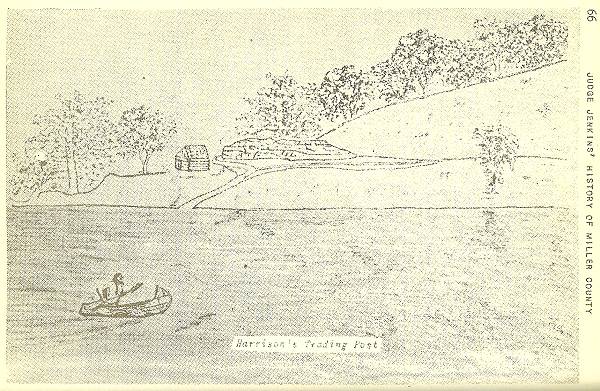
01 Harrison's Trading Post - Tuscumbia
This structure was the beginning of the settlement later known as the town of Tuscumbia.
The Harrison brothers’ earliest traders were the Osage Indians for whom a special area near the store was reserved for them to camp whenever they came to the trading post to stay a few days or weeks (photo 02).
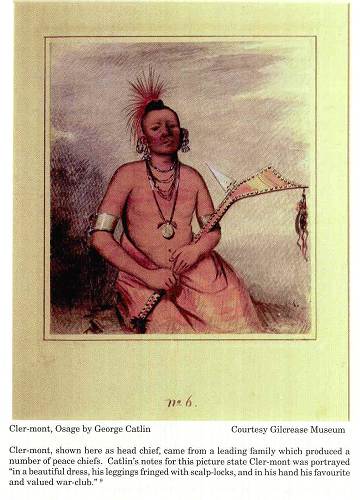
02 Cler-ment, Osage Indian
Click image for larger view
This trading post was the first place of business in Tuscumbia and also was the place where the name of the town officially was designated. According to Clyde Lee Jenkins’ book, History of Miller County, “…the county seat at Harrison’s Storehouse was officially named Tuscumbia on July 11, 1837, approximately 15 years after the official birth of Tuscumbia, Alabama” (p. 64).
The Harrison brothers were very important regarding the early history of Tuscumbia as documented quite well in Clyde’s book.
However, until historian Peggy Hake performed a rigorous study of the genealogy of the Harrison brothers, we may never have known that they were relatives of President William Harrison and considered “people of quality.” So I thought readers should know the rest of the story of the Harrison brothers, Tuscumbia’s first merchants, who had tremendous influence on the early history of Tuscumbia.
Note: Because the events described below occurred so long ago very few photos are available.
People of Quality Among Early Miller County Pioneers
By Peggy Smith Hake (photo 03)
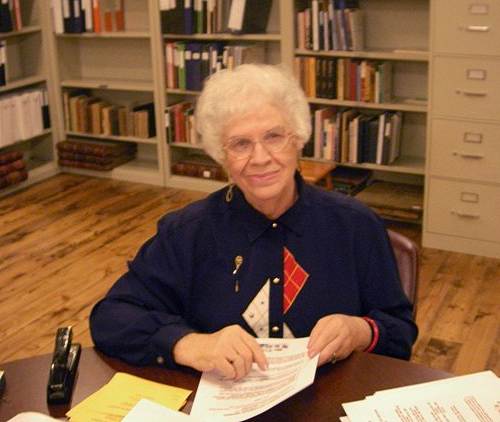
03 Peggy Hake
James Pryor Harrison and John Brazile Harrison, brothers and descendants of the Harrison family of England, who were called “people of quality,” were among the early pioneers of Miller County. James and John were from the same English family as our 9th President, William Henry Harrison.
Their great grandfathers were brothers form Yorkshire, England. President Harrison’s ancestor was Benjamin Harrison and he was an ancestor of James and John Harrison.
The grandparents of James and John were John Peyton and Mary Harrison of Botecourt County, Virginia.
John Peyton had several brothers and they all fought in the Revolutionary War. Only two of the Harrisons survived this war, John Peyton Harrison and Thomas Harrison, and it was through these two men that the Harrison family expanded in colonial America.
John Peyton’s children were Thomas, Rachel, John, Susannah, Sarah, Samuel, Daniel and James Berry.
Thomas Harrison moved west to Callaway County, Missouri and James Berry Harrison moved to present day Phelps County, Missouri.
In pioneer times, the rivers were the most important for travel and migration. Eastern folks floated the Tennessee, Ohio, and Cumberland rivers and then rowed up the Mississippi and Missouri rivers. As they came inland, they rowed the smaller tributaries of the Gasconade, Osage, Big and Little Pineys, Meramac, etc. in Central Missouri. Names of early settlers who came up the Gasconade, the Pineys, and Meramac included the Duncans and Harrisons and they settled in modern Phelps County near what was to become the town of Arlington. Missouri was only a territory at that time, not reaching statehood until 1821.
James Berry Harrison (1788-1842), son of John Peyton and Mary Harrison, married Louisa Voss Duncan (1799-1863), daughter of Robert Duncan and Hannah Carr. They were married in Spartanburg County, North Carolina near the town of Greenville. They had a large family of 14 children including John Brazile and James Pryor Harrison.
In 1818, James Berry Harrison and his family came to Missouri Territory and settled at the mouth of the Little Piney River near Arlington in present day Phelps County When they settled this frontier area of mid Missouri, the nearest house was at Steelville (Crawford County) and the nearest court was in St. Louis. The years James lived there, it was interesting to note that his home sat in five different counties as county after county was created around him (St. Louis County, Gasconade, Crawford, Pulaski, and finally Phelps County).
James Berry Harrison, father of John and James, was described as “a large, fine looking man, weighing about 250 pounds, with dark, curing hair.” If this trait was passed on to his sons, we can visualize huge, pioneer frontiersmen, venturing on into Miller County in the early 1830’s and building an Indian trading post on the Osage River at the present site of Tuscumbia.
James Pryor Harrison and John Brazile Harrison entered some land in present Miller County in 1836. Part of this land would one day become the capital city of Miller County, Tuscumbia.
They built a store and trading post on the left bank of a slough known as Shut-In Branch in the middle of a thick, dense forest and by a big spring. Here they conducted a large mercantile business, trading with the Osage Indians and the few settlers in the area. Their store building was constructed of hewn logs and was typical of a frontier trading post of early America (see photo 01 above).
Miller County was organized on February 6, 1837. James Pryor Harrison executed a warranty deed to the County of Miller for 50 acres to be used as a seat of justice for the new Missouri County. In the deed, Harrison reserved a plot of land, triangular in shape, for the Osage Indians who continued to trade with him. It was called Harrison’s reservation and in later years was the location of the Hauenstein’s Store building (photo 07).
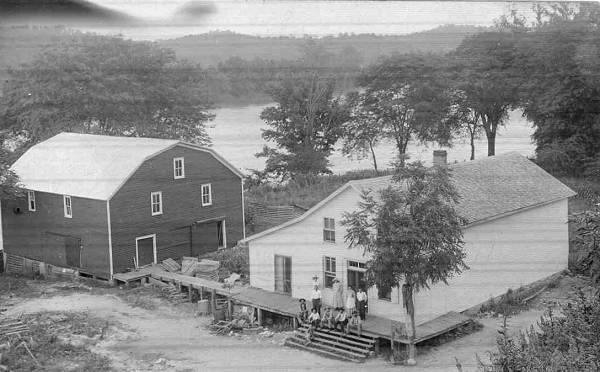
07 Hauenstein's Store - 1890's
Politics were in the nature and make up of the Harrison family. The Miller County Harrisons were successful politicians in local and state governments. James Pryor Harrison was appointed as the first clerk of the County Court and he also was appointed as the first clerk of the Circuit Court. His brother, John Brazile Harrison, served as Miller County’s representative in the State Legislature in 1840 and 1850. Earlier in 1838, he was elected to serve the same office from Gasconade County.
One of their distant cousins, William Henry Harrison of Indiana, was a more famous politician, the ninth president of the United States (see photo 04 above). The father of the president was Benjamin Harrison, the English immigrant who was one of the signers of the Declaration of Independence, a member of the Continental Congress and a governor of Virginia (see photo 05 above). The president’s family was outstanding in politics during early American history and on a smaller scale, Miller County’s Harrison brothers were destined to play a role in local and state politics.
While in Miller County, the Harrison brothers were active citizens, taking part in all phases of the county’s expansion and success. The first post office was established at Tuscumbia in December 1837 at Harrison’s Trading Post with James Pryor Harrison as the county’s first postmaster. Mail was carried through the county only once a week between Jefferson City and Waynesville via Tuscumbia. In 1844, John Brazile Harrison went into partnership with a man named Daniel Cummings and they erected a large building between the bluff and the big spring and became successful merchants of goods and groceries (photo 08).
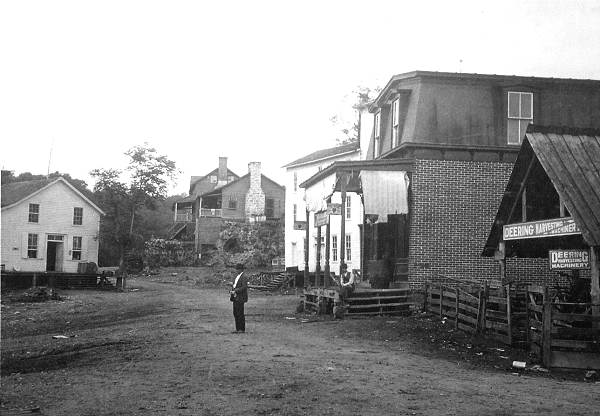
08 Hauenstein's Store on Left - Tom Robinson's Store on Right
White Building is Daniel Cummings' Store
John and James owned a ferry at Harrison’s Landing on the Osage at one time although it was in existence only about a year.
Note: Here is a photo of the landing at Tuscumbia taken many years later (photo 09):
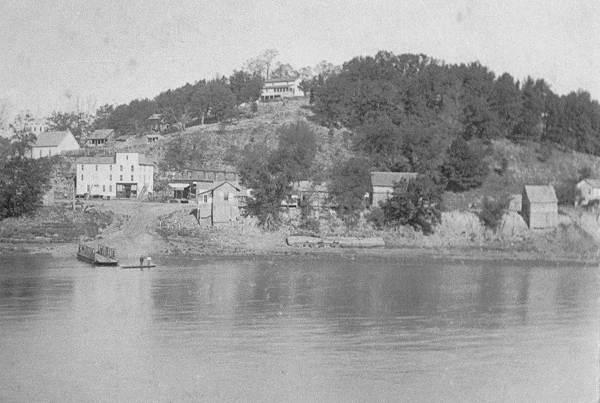
09 Ferry Landing at Tuscumbia - Cummings' Store next to Bluff
John Brazile Harrison was appointed as a road commissioner in 1838 to view and mark out the Tuscumbia-Little Piney road which ran from the ferry at Harrison’s Landing to the Pulaski County line. This road ran through the Big Richwoods and present town of Iberia and southeast into Pulaski County (about 21 miles) (photo 10).
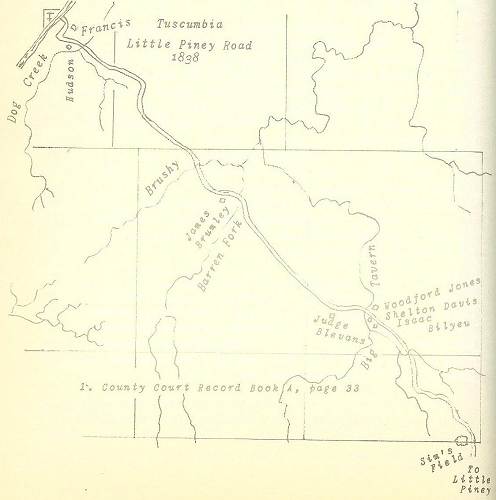
10 Tuscumbia Little Piney Road
Click image for larger view
It has been said that James Pryor Harrison and John Brazile Harrison were bachelor brothers, but John married Martha Lewellyn Hyer in Phelps County before 1840. She was a daughter of Samuel Hyer, owner of the Meramac Iron Works. They moved to Laclede County near Lebanon in 1853 and he died there in 1860.
James Pryor Harrison left Miller County about 1845-1850 when he decided to train as a doctor. In 1853, a medical school in St Louis awarded him a doctor of medicine degree. Thereafter he set up a medical profession where he practiced mostly in Pulaski and Phelps counties. He was the enumerator who recorded the 1850 Federal Census of Pulaski County, so he left Miller County prior to 1850.
Miller County has been the home of some very interesting people and the Harrison brothers are among the more interesting and colorful. They brought their noble English heritage into the wilderness with them and left the county with a rich lasting history of pioneering spirit and the hard work that carved a country out of our untamed forests.
ADDENDUM----July 14, 2011 Miller County Autogram
As I stated before, the Harrison family lived in England in Yorkshire and were people of quality. The progenitor of this family was Benjamin Harrison who had three sons, John, Benjamin Jr. and Thomas. The name Benjamin was handed down through the generations and was given to most of the oldest sons of each family. Old Benjamin had a grandson who came to America and his name was also Benjamin Harrison (see photo 05 above)! He was one of the signers of the Declaration of Independence and also served as a governor of Virginia. His son was William Henry Harrison, the ninth President of the United States (see photo 04 above). President Harrison was a third cousin to John Brazile and James Pryor Harrison, early pioneers of Miller County.
NOTE: The grandson of President William Henry Harrison
(Benjamin Harrison) was America’s 23rd President. They were the only grandson/grandfather to ever serve as president of the U.S. There have been two father/son combinations-- -John Adams and John Quincy Adams and George H. W. Bush and George W. Bush.
The parents of John and James were James Berry Harrison
(1788-1842) and Louisa V. Duncan (1789-1863). They came to central Missouri from the area of Greenville/Spartanburg, South Carolina. I think they had lived in Virginia earlier. They were slave owners and were enumerated with six slaves in the census of 1840.
The children of James Berry and Louisa (Duncan) Harrison were:
1. John Brazile Harrison
(who was once a county official of Gasconado Co., MO)
2. James Pryor Harrison (later became a doctor---also donated land for Miller Co.’s seat of government with his brother, John Brazile)
3. Robert B. Harrison (one of the organizers of Pulaski Co.,
MO)
4. Pamela Maria Harrison m. Hamilton Lenox (who may have been from the same family as Wilson Lenox who began a trading post at Oakhurst/Old Iberia)
5. Andrew Jackson Harrison---died young
6. William Perry Harrison- (moved to Audrian Co, MO and was in politics in that county.)
7. Benjamin Berry Harrison (founder of Lebanon, and donated land for the county seat of Laclede Co.)
8. Mary/Polly Harrison (1820-1900)
9. Thomas Carroll Harrison (owner of the paternal home called “Little Piney” in Phelps Co., near Rolla)
10. Marsha Harrison (no record found).
11. Malinda C. Harrison (no record found).
12. Eliza Louisa Harrison
Three Firsts:
The Harrison brothers in Miller County were involved in one way or another with the first county assessment, the first deed of trust, and the first courthouse. Each of these will be discussed below:
First County Assessment:
Miller County Autogram
Thursday, May 7, 1925
First Assessment Costs County $52
Hiram B. Russell Makes First Assessment in 26 Days
Otis W. Wright, revenue clerk in the State Auditor’s office, Jefferson City, and former assessor of Miller County, hands the editor of the Autogram two papers brown and musty with age which have been reposing in the State Capitol at Jefferson City since 1838 in the State Auditor’s office (photo 11).
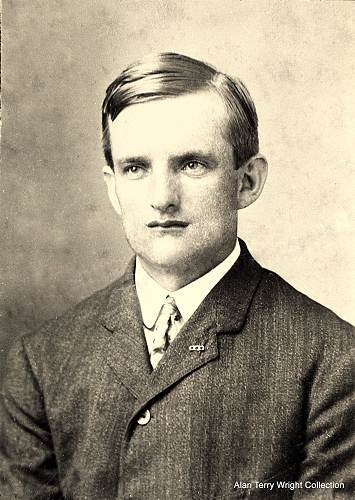
11 Otis Wright
These papers have to do with Miller County and give some interesting figures on the cost of assessing Miller County in its first year of existence. The first assessor was Hiram B. Russell, the progenitor of one of the prominent Russell families in Miller County today. During this time, 1838, J.P. Harrison was County Clerk. Mr. Harrison made requisites for the state’s share of Russell’s pay for his services, $52.00 to be paid by the State, and a like amount by the County. The official requisition for the state’s share made as follows:
“I, J.P. Harrison, Clerk of the County Court within and for the County of Miller, do hereby certify that the County Court of said County at the May Term thereof, 1838, allowed of an account in favor of Hiram B. Russell, against the State of Missouri, for fifty two dollars, the same being for the Twenty Six days services by him, the said Russell received in assessing the county of Miller making Assession Book for the year 1838. In testimony whereof I have hereunto set my hand and affixed my private seal there being no seal of said Court, as yet provided. Done at Office in the Town of Tuscumbia this 15th Day of May 1838.”
Signed
J. P. Harrison, CLK.”
At the bottom of the page is a receipt for the amount, signed by Russell. The receipt reads as follows:
“Record of the Auditor of Public Accounts a warrant on the Treasury for fifty two dollars in full of the above account this 17th day of May 1838, Hiram Russell.”
The other old paper mentioned an order for funds due Miller County from the State road and canal fund. This order was made in the first year of Miller county’s existence (1837) at the May term of the county court. The order was signed by J.P. Harrison, clerk, and the receipt for the funds received reads:
“Read, of the Auditor of Public Accounts a warrant on the Treasury for one hundred and ninety two dollars and fifty cents in full of the above order this 21st day of Mary 1838.
(Signed)
John B. Harrison”
First Deed of Trust:
Miller County Autogram,
Tuscumbia, Missouri
(Date Approximately late 1920’s or early 30’s)
Miller County’s First Deed of Trust Recorded August 18, 1837
Land Now Owned by Joseph Hoecker, on Osage River, Was First Real Estate Incumbered After County Was Organized
By Lawrence Wright (photo 12)
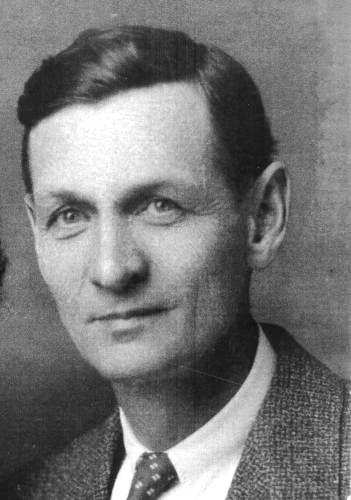
12 Lawrence Alfred Wright
In deed of trust, record book A, at page 1, in the office of the recorder of deeds of Miller County will be found the first mortgage entered of record after Miller County was organized and came into its own. It is now more than 100 years since this deed was filed, and ever since that time people of Miller County have often resorted to this legitimate means of buying land.
The old record, brown with age, and with a leather cover, crumpled somewhat at the corners, is yet fairly legible. The ink has also turned brown with age. An act of the legislature organizing Miller County was approved by the Governor February 6, 1837, and the first mortgage was recorded August 18, 1837.
This mortgage was given by Seth L. Cole of St. Louis County to Samuel Richardson, and was in consideration of the sale to Cole by Richardson of 289.62 acres of land on the Osage River. The consideration was $1200.00, and the mortgage was for $1,100, so Cole must have paid $1100 in cash. This land is now owned by Joseph Hoecker. About 59 acres of the tract mortgaged is in Cole County where the county dips over the Osage and takes in that part of the Hoecker farm where the tie chute is located. Most of the land is located in the bottom being some of the finest land on the river, and it would be worth many times the purchase price today.
Note: Here is a plat map image of this property after Joseph Hoecker bought it years later (photo 13):
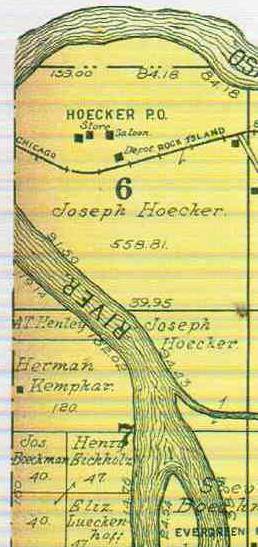
13 Rock Island in Osage Township going through Hoecker Farm
The form of mortgage used 100 years ago is very similar to that of today, and the deed is herewith reproduced for the benefit of our readers:
“THIS INDENTURE, Made this seventeenth day of August in the year of our Lord eighteen hundred and thirty seven between Seth L. Cole of the County of St. Louis in the State of Missouri of the first part and Samuel Richardson of the county of Miller and State aforesaid of the other part.
“Wiitnesseth, That the said Seth L. Cole for and in consideration of the sum of eleven hundred dollars, to him paid by the said Samuel Richardson the receipt whereof is hereby acknowledged hath granted, bargained, sold and conveyed and by these presents doth grant, bargain, sell and convey unto the said Samuel Richardson and unto his heirs and assigns, forever all those tracts or parcels of land, to with:
“The northeast fractional quarter of Section Six (6) Township No. Forty one (41), north of the base line and west of the fifth principal meridian, Range No. Twelve, containing one hundred and thirty nine acres. The southwest and southeast fractional quarters of Section No. Thirty one (31), Township H. fjorty two (42) north of the base line and west of the fifth principal meridian Range No. twelve (12), containing fifty nine acres and twelve hundredths of an acre. The southwest fractional quarter of Section Six (6), Township No. Forty one (41), north of the base line and west of the 5th meridian Range No. Twelve (12) containing ninety one acres and fifty hundredths of an acre.
“To have and to hole the premises aforesaid, with all the privileges and appurtenances thereunto belonging or in anywise appertaining unto him the said Samuel Richardson and his heirs and assigns forever; Provided always that these presents are upon these express conditions that if the said Seth L. Cole his heirs, executors or administrators, shall pay or cause to be paid to the said Samuel Richardson his heirs, executors or administrators or assigns the sum of eleven hundred dollars, two hundred dollars of which is to be paid on the first day of January, 1838 , and the remaining nine hundred to be paid on the first day of March, 1839, together with the interest that may accrue thereon in manner particularly specified in a certain note or obligation bearing even date herewith executed by the said Seth L. Cole to the said Samuel Richardson and the said Seth L. Cole shall pay to the said Richardson the sum of fifteen dollars for foreclosing this mortgage if it becomes necessary so to do, then and from thenceforth these presents and everything herein contained shall cease and be void anything herein contained to the contrary notwithstanding.
“In Testimony Whereof, I have hereunto set my hand and affixed my seal this day and year first, above written.”
S.L. Cole
County of Miller
State of Missouri
“Be it remembered that on this seventeenth day of August in the year of our Lord eighteen hundred and thirty seven before me the undersigned Clerk of the Circuit Court within and for the county aforesaid personally appeared Seth L. Cole who is personally known to me to be the person whose name is subscribed to the foregoing instrument of writing as having executed the same and acknowledged the said instrument to be his act and deed for the purposes therein mentioned.”
“Taken and certified the day and year first above written.”
J. P. Harrison, Clerk
“Truly recorded this 18th day of August, 1837. J.P. Harrison, clerk”
First County Courthouse:
The Miller County Autogram
September 28, 1922
Lawrence Wright
First Substantial Court House Built of Brick In Years 1857-1858
Contract Was Let November, 1857, to Robert McKim at His Bid of $6,000, With Stipulation That He “Insure Speedy Completion.”
Built on land donated by John Harrison
How many people in Miller County know that the first “real” courthouse in the county was built before the Civil War and that prior to that time court was held in a log building built in 1839 (photo 14)?

14 First Courthouse built in 1839
Back in those days the county court was composed of three justices, the presiding justice being designated the president of the court. They not only looked after the business of the county as does the present county court but probate matters were in their hands.
It was at the December term, 1856, of the court that a petition signed by various citizens of the county was presented to the court:
“Praying this court to adopt such measures for the building of a new court house as will insure the speedy completion of same; and the court here decreeing it expedient and of the best interest to the county. It is therefore ordered by the court that the sum of four thousand dollars of any money belonging to the county and applicable to the purpose be and the same is hereby appropriated for the purpose of building a new court house for the county of Miller and it is further ordered by the court here that Owen Riggs be and is hereby appointed Superintendent, to superintend the erection of the same, and it appearing to the court here that there is no suitable ground on which to build said courthouse belonging to said Miller County, it is therefore ordered that said Superintendent select a proper piece of ground for that purpose at the seat of justice of said county and purchase or receive the same by donation and take good and sufficient deed or deeds therefore to the county, and that said Superintendent make report of his proceeding to Miller County Circuit Court at its net sitting” (photo 15).
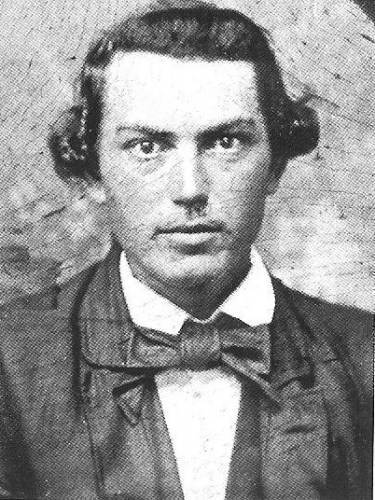
15 Superintendent Owen Riggs
The court and officers present were the Honorable Joseph Johnson, Samuel Allen and Samuel J. Jones, justices of said court, William P. Dixon clerk and James Johnston sheriff (photo 16).
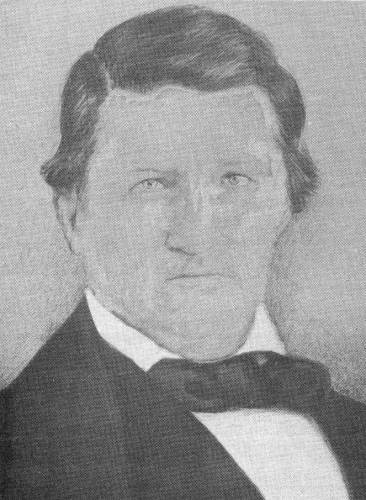
16 William Powell Dixon
At the March term of court Owen Riggs presented the plan for the courthouse. It was to be 56 feet long, 40 feet wide, 2 stories high, built of brick, with stone foundation, first story to be fourteen feet high and walls 18 inches thick, second story to be 12 feet high and walls 13 inches thick. Provision was also made for partitioning building for the various offices. There was to be one entrance and all windows and the outer door were to have stone sills and caps. The court advertised for bids in three newspapers: “Weekly Jefferson Examiner,” Weekly Jefferson Inquirer,” and “Weekly Missouri Republican.” The contract was let November 7, 2857, to Robert McKim at his bid of $6,000 and was to be paid as the work progressed. (Years earlier the present court house site had been donated by Mr. Harrison.) E.B. Farley was then appointed Superintendent of construction. In making one of his reports to the court when the walls were nearing completion, Mr. Farley advised the court that contractors were not using enough lime in the mortar and that too many bats or small pieces of brick were going into the wall. He found fault with the construction of the north wall which he said was very rough and contained too many broken pieces of brick.
After the building was completed, February 1859, the court makes this significant order:
“E.B. Farley is hereby appointed Commissioner to have charge of new court house in Tuscumbia, and he is hereby authorized and directed to adopt such measures and regulations as he may deem necessary for the preservation of the building, subject to the approval of the Court. It is further ordered, Justices Allen and Jones concurring and Justice Golden dissenting, that said Commissioner be and is hereby directed and required to prohibit and close the doors of the Court House against cotillion or dancing parties, preaching, singing or public worship of any kind, tea parties and all other parties or assemblies except for political purposes.”
Note: Here is a photo of the old brick courthouse which replaced the log cabin structure before it (photo 17):

17 2nd Courthouse finished in 1859
More could be written about the Harrison brothers influence on the early development and growth of Tuscumbia, but the above articles should suffice to confirm just how important their efforts were to the town and surrounding community. Interestingly, neither brother made Tuscumbia their final destination. Both moved out of the area in later years as noted above in Peggy Hake’s biography of the brothers.
Alan Wright, who is an occasional contributor to this page, wrote me a short essay in reference to my article about Raymond Abbett in the Progress Notes of April 16, 2012 which adds more information to the story of the tragic life of Raymond Abbett:
Tragedies of Raymond Abbett, Willard Howser, Ruby Colvin and Homer Walters
Alan Wright (photo 18)

18 Alan Wright
Joe,
I was fascinated with your fine article about Raymond Butterfield Abbett. What a sad and poignant story! An orphan, a veteran, a young married man with children--who survived a car accident--but was electrocuted by the downed wires. Life can be very unfair (photo 19).
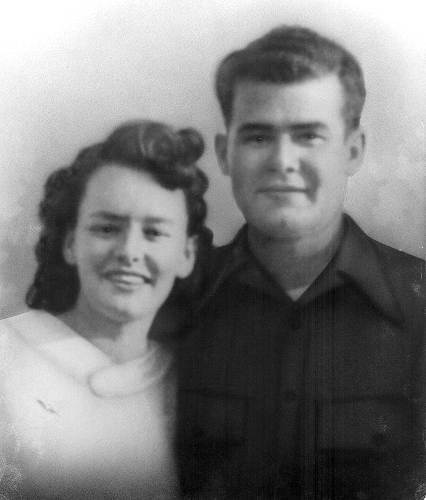
19 Raymond and Mary Edwards Abbett
I'm wondering if the story of Raymond Abbett matches a vivid recollection from my childhood. Garsy and Ruby Wright's (my mom and dad) home once stood almost exactly midway between the junction of Highway 54 and 17 and the town of Etterville (photo 20).
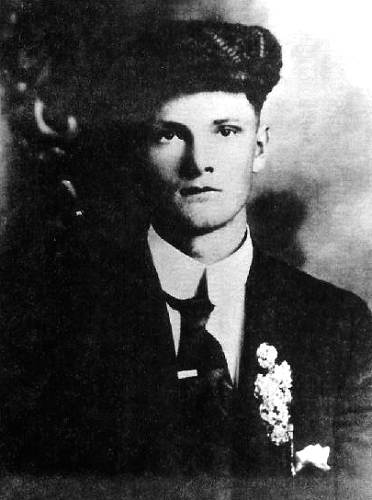
20 Garsey Lloyd Wright
When I was about five (in 1951 and 1952), sometime in the early evening, the lights in the house flickered badly and then later went completely out. I don't know how mom cooked supper that evening, but she likely got out the old kerosene lamps to provide light. I'm pretty sure that dad later told the family that a man had hit a power pole down toward Etterville, on "Willard Hill," and had been electrocuted. According to Raymond Abbett's death certificate, he was killed at 4:30 in the afternoon of Saturday, April 12, 1952, one mile east of Etterville, which would have placed the accident at or near "Willard Hill."
I don't remember the power coming back on, but of course we were probably all in bed by 9:00 P.M. If my recollection is of the same event, the account becomes riveting to me since it provides the name, face, and real life story of the man whose death I "witnessed" the moment the lights flickered when I was only five. We were served by Three Rivers Electric Cooperative, which did not serve that stretch of Highway 54 until 1949 or 1950. So, had Abbett's accident been only a couple of years earlier, there would have been no hot wires for him to touch.
Winston Wright, who assisted at the scene, I believe taught school at Tuscumbia, and was the son of Frank Wright, my father's first cousin (photos 21 and 22).
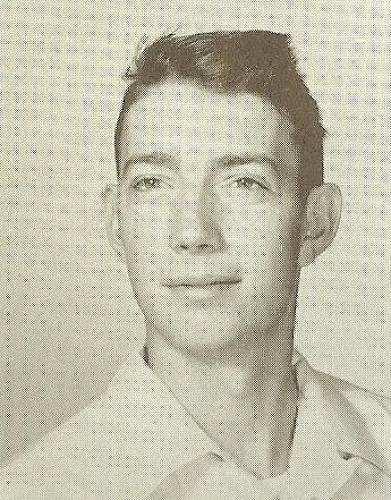
21 Winston Wright
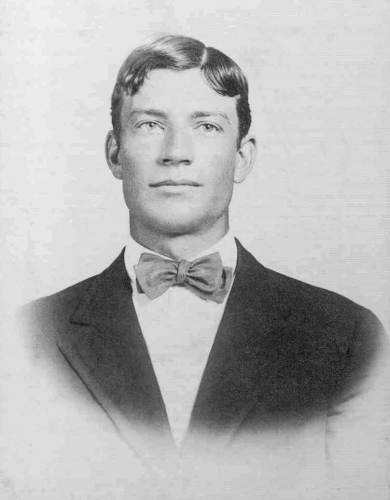
22 James Franklin Wright
These days, folks are told to stay in a wrecked car that involves downed wires, until the power company or fire department can cut the power. Then, folks were less well schooled in the dangers of electricity.
By the way, "Willard Hill," in those days, was about a mile east of Etterville and descended rapidly, east bound, with a fairly sharp right hand curve at the bottom, with a narrow bridge having concrete abutments---a very dangerous stretch indeed. The curve is still there, but made more manageable by the widening of Highway 54 in the 1970s. It was named "Willard Hill" after a farmer, Willard Howser, whose farm comprised most of the hill on the north side of the highway. Willard Howser also died tragically, when he burned up in his house, sometime, I think, in the late 1950s or maybe early 1960s. At the time, he was a bachelor---I do not know whether he was ever married and had a family or not.
Another tragedy in the vicinity of Abbett's death was the drowning of Ruby Colvin, age 21, and Homer Lewis Walters, age 25, Friday, July 16, 1937, in a rock quarry, about one mile south and east of Willard Hill, just beyond the Rock Island railroad tracks. As I understand it, the quarry, referred to by many locals as the "lime kiln," had been created to provide Portland cement and crushed rock for the construction of U.S. 54 through the area in the early 1930s. Convicts from the Missouri State Penitentiary provided some of the labor. By 1937, the 80-90 foot deep hole, with steep drop offs, had been abandoned and had filled with pure, clear water from underground springs. It was then, and remains now, a lovely place. The area had once been the bed of an ancient sea. In our childhoods, my brothers and I collected hundreds of fossils of early living creatures there.
At about 10:00 P.M. on that Friday evening, a group of young people, who had likely walked down the Rock Island line from the vicinity of Etterville, were "partying" and having a good time, probably having built a camp fire. Since it was July and warm, some were likely swimming in the cool waters. The account that my mom and dad heard was that Miss Colvin somehow fell into the water, which immediately put her in over her head. Unable to swim, she cried out for help, and young Mr. Walters dived in to rescue her. Sadly, she panicked, clinging so tightly to him that they both quickly went down together. Later that night, when workers with boats and grappling hooks were brought in to retrieve the bodies, powerful spotlights disclosed the couple lying peacefully on the bottom in the clear water, some 80 feet below the surface. They remained in a tight embrace, their fates forever entwined.
Ruby Colvin, listed as "living on a farm," was the daughter of Peter and Marjorie (Wyrick) Colvin of Etterville, was buried at the Mt. Zion Cemetery, near Tuscumbia. Homer Lewis Walters, listed as a "farmer," had been born in Shannon County, Missouri and was the son of George and Lola (Perkins) Walters of Fremont, Missouri, in Carter County, near Van Buren. Walters' body was taken home to be buried at Fremont.
What had brought Mr. Walters to Miller County from his roots in the beautiful float stream country of Southern Missouri? I do not know. Whether Colvin and Walters were lovers, just friends, or perhaps met for the first time in those cold, deep waters, is also unknown. Perhaps an older reader of the "President's Page" might shed some light on this sad drama from Miller County's history of the 1930s.
Alan Terry Wright
Sometimes the sources for the Progress Notes page come from unexpected locations. For example, recently, Brice Kallenbach brought me a “smart card” he found in the grass of our museum campus. The date recorded on the card was April 16, 2011, so it had been lost for about a year. Amazingly, the content of the smart card was intact, depicting a moving panoramic view of our Civil War display in the museum. You can use the pause button to fix in place any part of the panoramic scene. The center display features the story of the Bear family which sent six sons to join the north in the Civil War.
In this sesquicentennial year of the Civil War we plan to enlarge our Civil War display in June.
Last week the Jason Ash Veterans’ memorial monument was placed on our museum campus (photos 23, 24 and 24a).
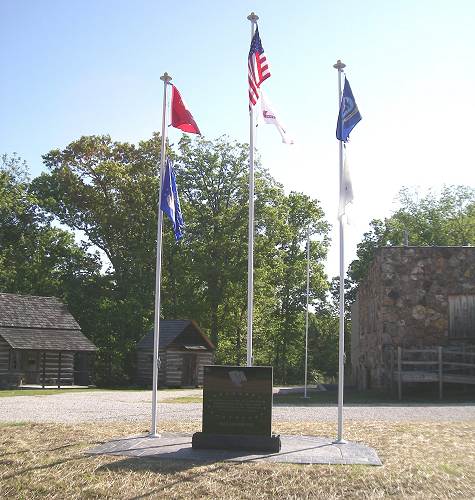
23 Jason Ash Memorial

24 Jason Ash Memorial
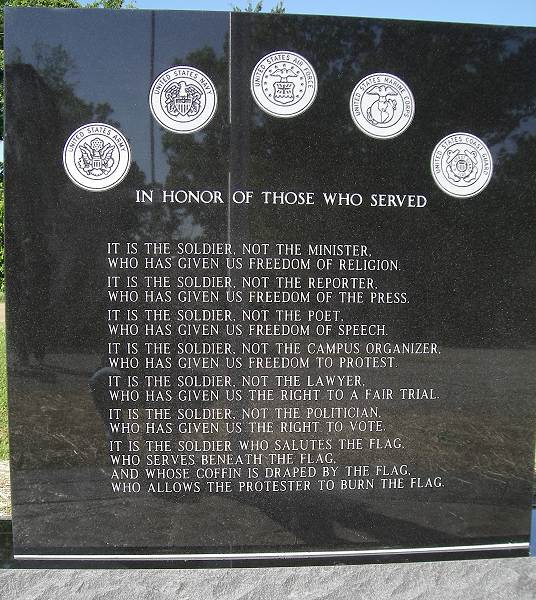
24a Jason Ash Memorial
Jason was a Tuscumbia native who tragically lost his life from a work related injury July 19, 2007. The monument offers a tribute and honor to all our nation’s veterans. We were honored that the Jason Ash memorial committee chose our museum campus to place this very patriotic tribute to the men and women of our armed forces.
A dedication of the memorial is planned for May 19.
Finally, take a look at this monster tree (photo 25):
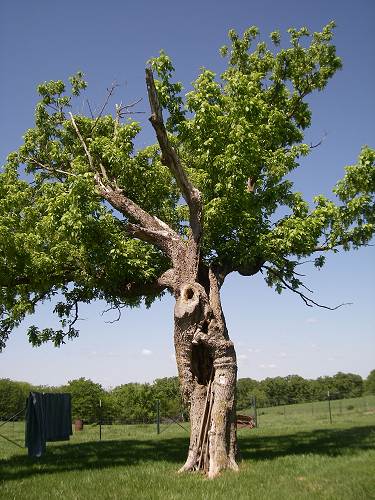
25 Tree Monster
Springing forth at the top are its horns, in the middle is a large nose and two big eyes, a big hole in the stomach area, arms on each side of the hole, and two legs below. The tree is on a farm once owned by John Adcock, the J.R. Wells steamboat captain featured in last week’s Progress Notes.
That’s all for this week.
 Joe Pryor
Previous article links are in a dropdown menu at the top of all of the pages.
|

